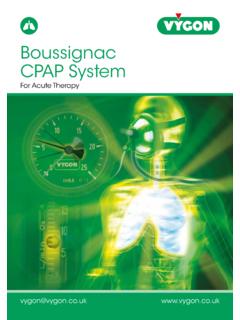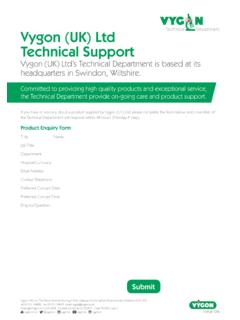Transcription of Neonatal & Paediatric catheters - Vygon
1 Neonatal & Paediatric catheters Specialist Products for Newborns & Young Children A range of Neonatal and Paediatric intravenous catheters providing safe and reliable vascular access for all children from newborn <1kg to children >1yr Product Selection Matrix Introducer and Access Point Selection Now put together the information you have gathered and consult the matrix to find the recommended product to meet your requirements. Table 1 - Introducer Method Preferred Introducer Method Preferred Access Point Recommended Product Introducer Method Application Advantage Disadvantage NEWBORN. Cut-down Umbilical catheters Direct vision insertion A surgical procedure < 1kg Umbilical catheter Cut-down Umbilical (1270 Single, 1272 Double). Plastic through plastic Introducer is larger than Microflash Peripherally inserted catheter Scalp, ACF, 28G Premicath insertion the catheter Breakable Needle Central lower leg, foot ( ). Venepuncture hole is Breakaway Needle Peripherally inserted catheter Plastic through metal insertion smaller than a cannula Venous Scalp, ACF, 28G Premicath Microflash Removable Needle Peripherally inserted catheter Small venepuncture hole Large needle, two part construction lower leg, foot ( ).
2 Arterial or venous, peripheral The venepuncture hole is Can be tricky with an uncooperative Scalp, ACF, 24G Nutriline Twin-Flo Seldinger Microflash or central insertion routes smaller than the catheter child lower leg, foot ( ). Arterial Umbilical catheter Cut-down Umbilical Table 2 - Primary Access Points (1270 Single, 1272 Double). Preferred Venous Sites Veins Hand Digital, metacarpal Preferred Introducer Method Preferred Access Point Recommended Product Forearm Supplementary cephalic, basilic, median antebrachial NEWBORN. Antecubital fossa (ACF) Median basilic, median cephalic, median cubital > 1kg Umbilical catheter Cut-down Umbilical (1270 Single, 1272 Double). Upper arm (below axilla) Basilic, cephalic Forearm, ACF, 24G Nutriline Foot (before walking age) Greater saphenous, lesser saphenous Microflash lower leg, foot (1352). Central Scalp (before six months) Occipital, metopic, temporal Venous Removable Forearm, ACF, 24G ECC. Lower leg (before walking age) Greater saphenous, lesser saphenous Butterfly Needle lower leg, foot (2184).
3 Scalp, ACF, 24G Nutriline Twin-Flo Microflash lower leg, foot ( ). Frontal or Superficial Internal Dorsalis Metopic Vein Temporal External Jugular Pedis Vein Jugular Artery Vein Vein Umbilical catheter Cut-down Umbilical Occipital Subclavian (1270 Single, 1272 Double). Vein Vein Arterial Cephalic 22G Leaderflex Posterior Vein Seldinger Wrist, femoral, foot Ulna Auricular (1212). Artery Vein Basilic Radial Artery Vein Preferred Introducer Method Preferred Access Point Recommended Product CHILD. Table 3 - Secondary Access Points > 1yr Secondary Venous Sites Potential Complications Wrist Superficial veins: infiltration in this area may result in pressure on the radial nerve ACF, upper arm, 22G Leaderflex Seldinger Superficial veins: rarely used, usually limited to neonates and chronically hospitalised patients; infiltration may Central femoral, forearm, jugular (1212). Abdomen result in damage to abdominal wall Venous ACF, upper arm, 20G Nutriline Axilla Axillary vein: usually limited to neonates; infiltration may cause pressure on structures in chest cavity Peelable Cannula forearm ( ).
4 Knee Popliteal vein: usually limited to neonates due to decreased mobility 22G Leaderflex Arterial Seldinger Wrist, femoral, foot (1212). Please Note: Sites are listed in order of preference, but consider individual characteristics. Long Line Placement Pack Complementary Products Secondary sites should be considered only when preferred sites are not available. ( ). Custom Summary of Education and Placement 20G 22G 24G 24G 24G Nutriline 28G Umbilical Packs Complications Training Packs Nutriline Leaderflex Nutriline Twin-Flo Premicath catheters catheters Umbilical Umbilical catheters NEWBORN NEWBORN. The safest choice for short-term vascular access in neonates < 1kg > 1kg A range of single and double lumen umbilical catheters The use of double lumen venous umbilical catheters in for both venous and arterial use. Patient safety has critically ill neonates is well tolerated and decreases the been improved by the use of polyurethane, which, unlike need for additional venous catheters .
5 (1). traditional PVC catheters , remains inert for the life of the catheter . Features and Benefits Polyurethane catheter remains firm during insertion but softens at body temperature, minimising vessel trauma and enhancing stay time. X-ray opaque for accurate tip location without additional contrast medium. Numerical graduations aid accurate tip placement. Atraumatic tip reduces risk of vessel damage during insertion. Double lumen venous catheter decreases the need for additional IV. access. Slide clamps (on double lumen only). for line management and safety. Ordering Information Product Codes Size Length Priming Flow Rate Unit of Description Vygon NHSSC (Fr) (mm) Volume (ml) (ml/min)* Sale FSY023 Single lumen PUR catheter with three-way tap 300 - 8. FSY024 Single lumen PUR catheter with three-way tap 400 - 8. FSY025 Single lumen PUR catheter with three-way tap 400 - 20. FSY026 Single lumen PUR catheter with three-way tap 400 - 20. FSY027 Single lumen PUR catheter with three-way tap 400 - 20.
6 FSY028 Double equal lumen PUR catheter with three-way tap 200 / / 10. *Tested to ISO 10555. e Reference qu ni 1. Dr A. Soe and R. Buckle. Specialist ch te af Clinical Audit Programme for London, on rle Kent, Surrey and Sussex. March 2004. rti ve se o In catheters Umbilical Umbilical catheters NEWBORN NEWBORN. The safest choice for short-term vascular access in neonates < 1kg > 1kg Insertion Technique General 1. Use strict aseptic technique and ensure maximum barrier precautions, such catheter as using the umbilical placement pack ( ), cleanse the anterior Iris Forceps abdominal wall and cord stump. Vein 2. Loosely tie a piece of ribbon gauze around the cord stump to control bleeding. Cut the umbilical cord at its base, tangentially to the abdomen, remove any clots which may obstruct the vessel lumen. 3. Arteries are small, thick-walled spiralling vessels, whilst the vein is larger Ribbon Artery and thin-walled (see diagram 1). Gauze 4. Prime the catheter , and if required dilate the vessel using iris forceps 1.
7 (see diagram 1). 5. Advance the catheter using short, smooth strokes. Diagram 1 - catheter insertion Arterial Catheterisation 1. Place the catheter tip either at the upper aorta above the diaphragm, X-ray T6-T10 (see table 1 and diagram 2) or in the lower aorta below the renal arteries, X-ray L4-L5 (see table 1 and diagram 2). IVC. 2. Check the legs and buttocks for pallor or blueness and palpate the femoral T6-10. pulses. Ductus Venosus 3. Confirm catheter location by X-ray. Portal 4. Fixate the catheter . Vein Venous Catheterisation L4-5. 1. Locate the catheter tip into the inferior vena cava via the ductus venosus 2. (see diagram 2). 2. Confirm catheter location by X-ray. 3. Fixate the catheter . Diagram 2 - catheter tip location Please note: Any resistance to the advancement of the catheter must lead to immediate withdrawal of the catheter by 2-3cm before any new attempt is made. Do not cover the umbilicus with any dressing as the cord air dries in the Table 1. incubator. Umbilical Artery catheter catheter removal: Withdraw the catheter slowly and gently.
8 If resistance is felt, Positions stop and identify the cause before continuing. Shoulder Umbilicus Umbilicus umbilicus lower aorta upper aorta length (cm) length (cm) length (cm). 8 4 10. 10 5-6 12. 12 6-7 15. 14 8 18. 16 10 20. 18 10-11 22. Warnings: Avoid the use of alcohol or acetone to clean the catheter as this may result in catheter damage and premature removal. Avoid the use of small syringes less than 10ml for bolus injections as they generate high pressures which may result in catheter damage. Vygon (UK) Ltd, The Pierre Simonet Building, V Park, Gateway North, Latham Road, Swindon SN25 4DL. T: 01793 748800 | F: 01793 748899 | W: | E: 28G Premicath NEWBORN. Neonatal catheter (PUR) with choice of introducer < 1kg Premicath 28G Premicath has been designed specifically for use needle introducer, which is ideal for use in the tiniest of 28G. with babies under 1kg who require the smallest catheters . veins, or the slightly larger Microflash peelable cannula As with our other polyurethane catheters Premicath which provides the added safety and security of advancing utilises thin-wall technology to enable optimum flow rates the catheter through plastic, and the ability to completely to be achieved.
9 Remove the cannula after line insertion. Clinicians have the choice of either a small breakaway Features and Benefits Polyurethane catheter remains firm during insertion but softens at body temperature, minimising vessel trauma and enhancing stay time. X-ray opaque for accurate tip location without additional contrast medium. catheter graduations every cm aid accurate tip placement. Small 28G catheter for the smallest veins. One-piece catheter construction simplifies insertion. Integral extension with wing permits secure catheter fixation, reducing the risk of mechanical phlebitis. Choice of introducer: Microflash introducer unique split cannula, allows easy removal from the PICC line, and eyelet gives rapid visibility of flashback. Small 24G breakaway needle for small veins. Kit Contents 1 x catheter 1 x Microflash introducer or breakaway needle 0896 Bionector needle-free access devices available separately. Ordering Information Product Codes Introducer Information Unit Size Length Priming Flow Rate Description Size of Vygon NHSSC (G) (mm) Volume (ml) (ml/min)* Type (OD-L-G) Sale FSU221 X-ray opaque graduated catheter 28 200 Breakaway needle 10.
10 FSU220 X-ray opaque graduated catheter 28 200 Microflash 10. - X-ray opaque graduated pur catheter with stylet 28 200 Breakaway needle 10. FSU263 X-ray opaque graduated pur catheter with stylet 28 200 Microflash 10. FTR438 Breakaway needle only 24 18 - - Breakaway needle 25. FSP244 Microflash introducer only 20 18 - - Microflash 25. *Tested at 1 e qu ni ch te af on rle rti ve se o In 28G Premicath NEWBORN. Neonatal catheter (PUR) with choice of introducer < 1kg Premicath Insertion Technique 28G. Preparation for catheter Insertion Open using aseptic technique. Add any sterile supplementary equipment needed. Ensure maximum barrier precautions, such as using the long line placement pack ( ). Put on sterile gloves and prepare tray contents ready for catheter insertion: 1. Draw-up saline and heparin flushes using a filter needle or straw to remove particulate material. 2. Flush catheter prior to insertion. Microflash Cannula Insertion Technique 1. Select, prepare, clean (see diagram 1) and drape site of venepuncture.















